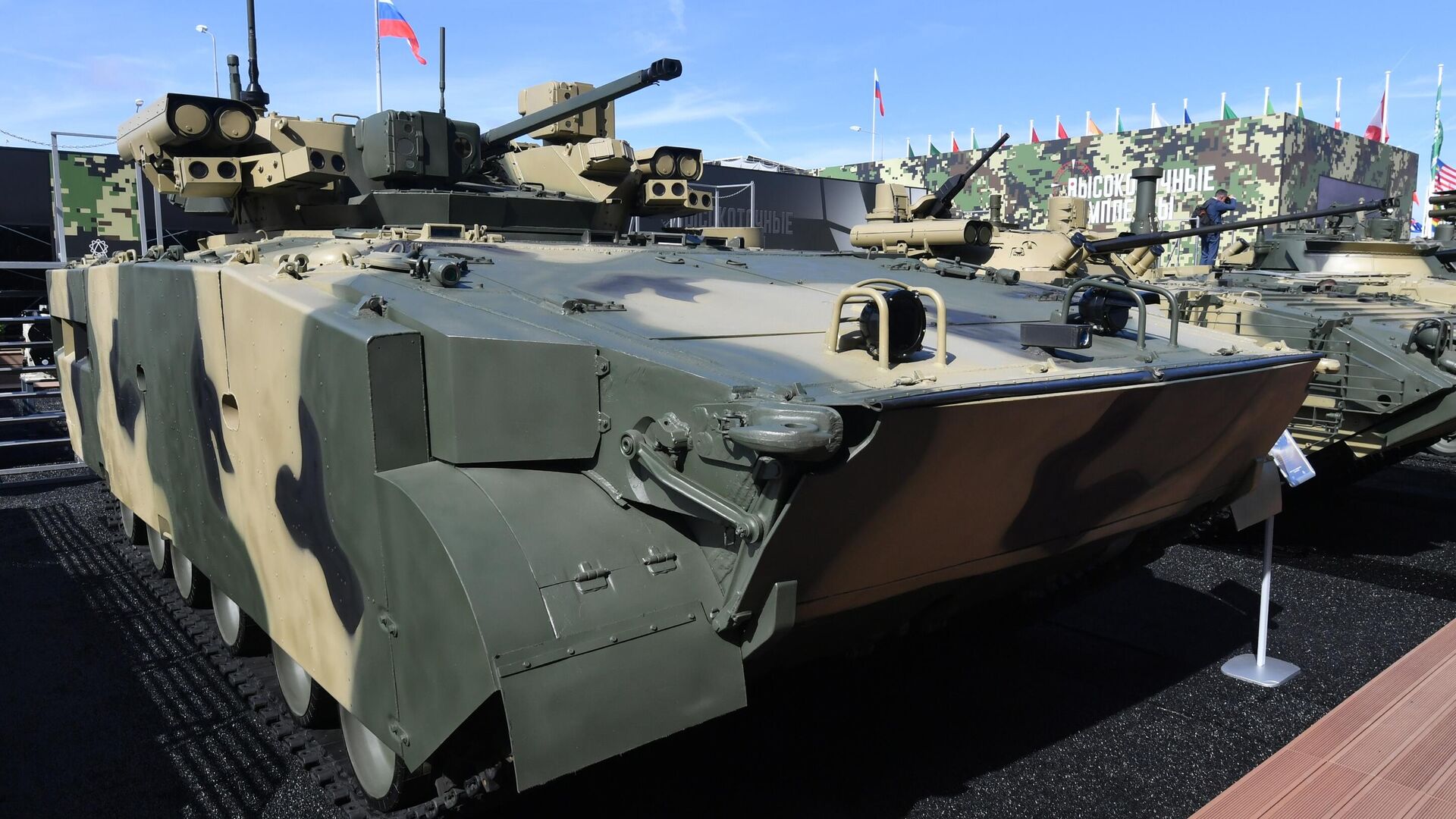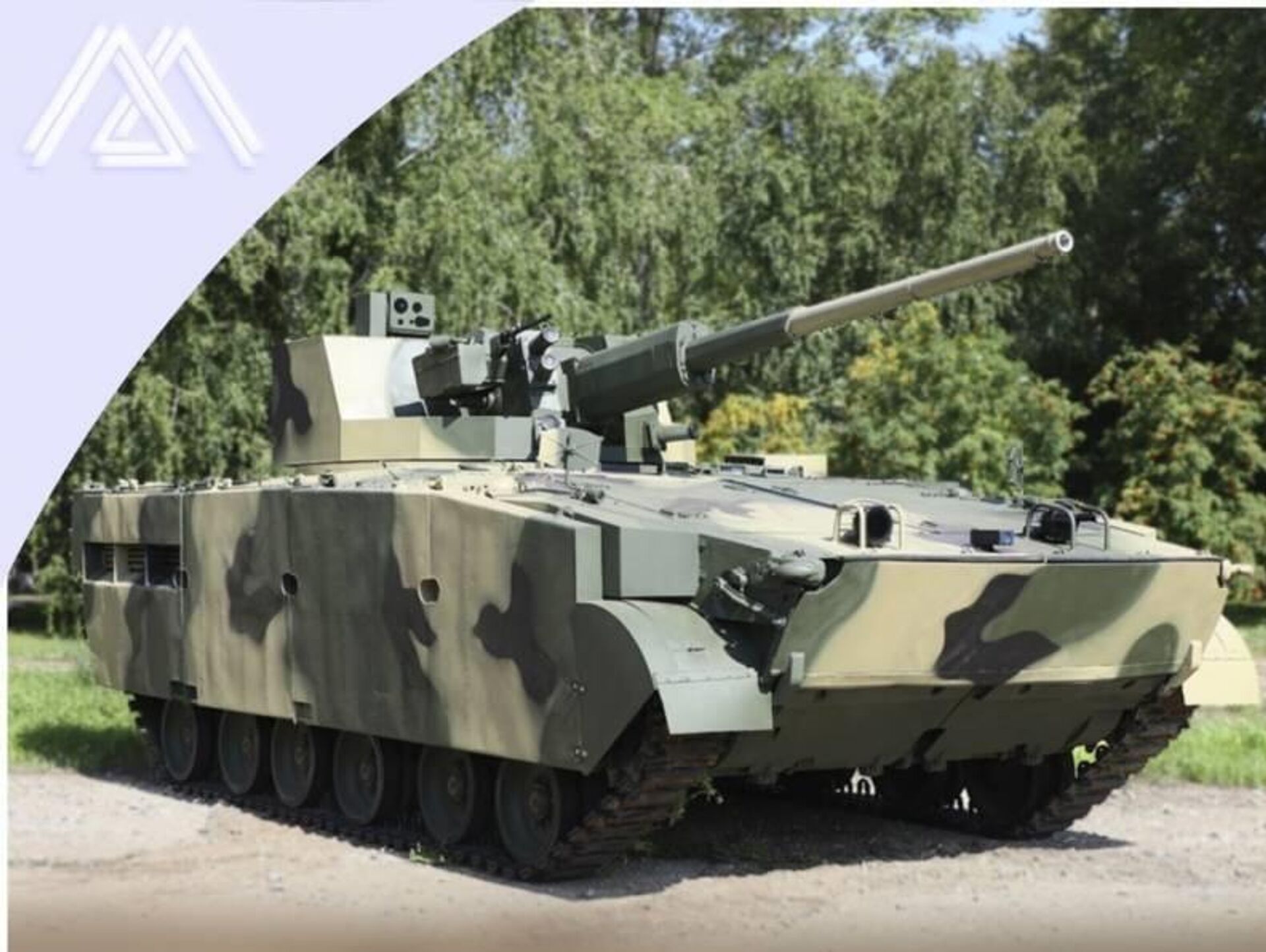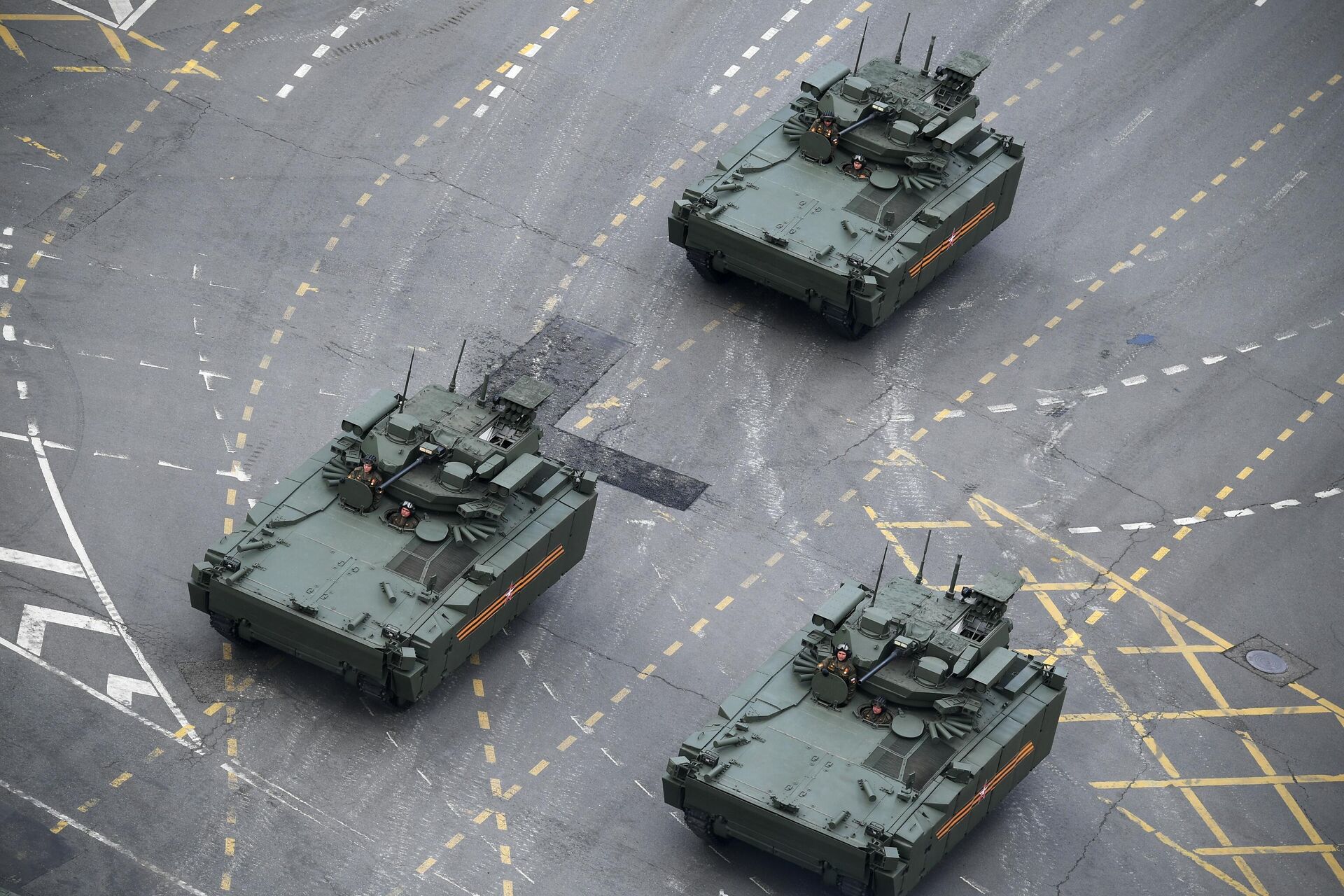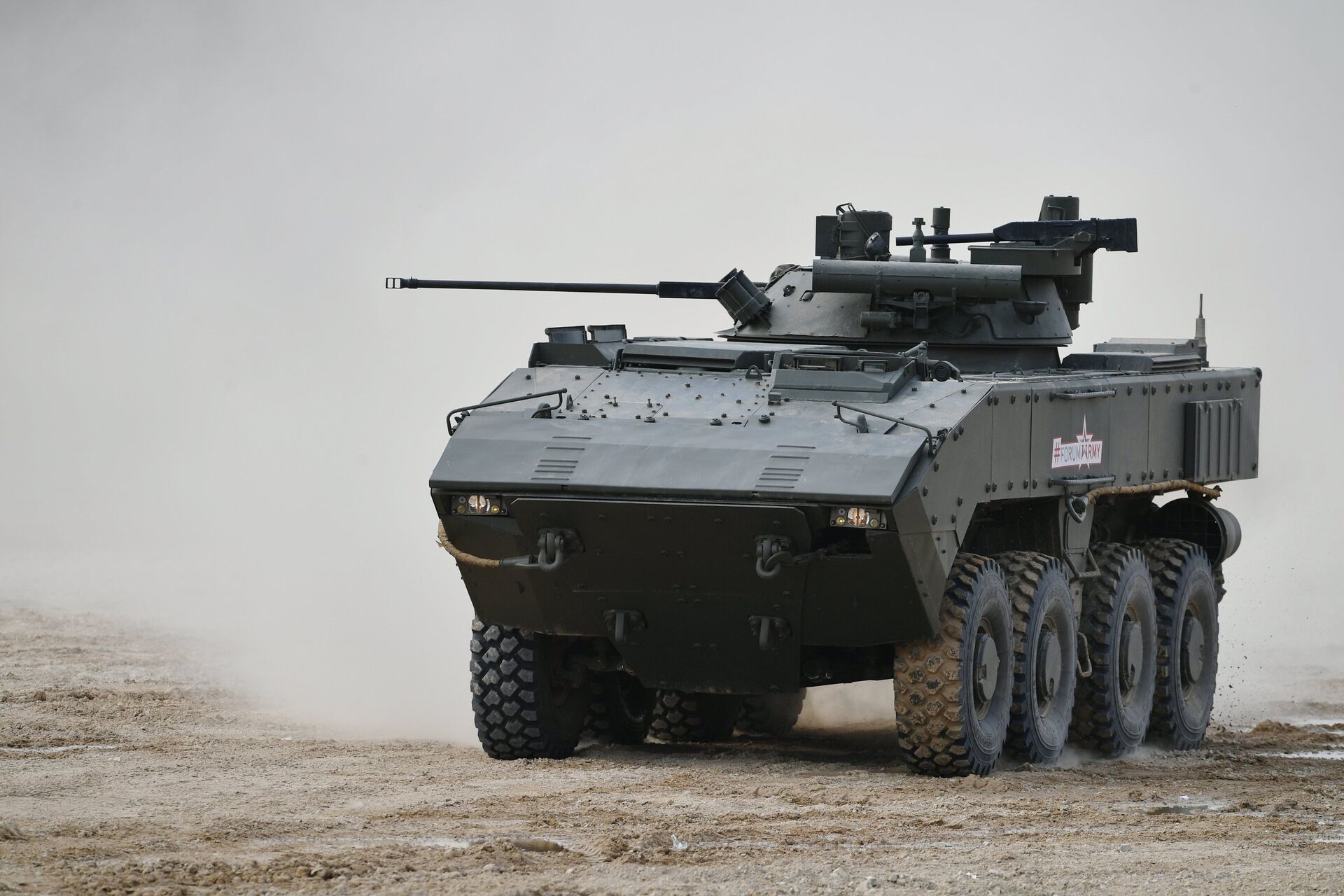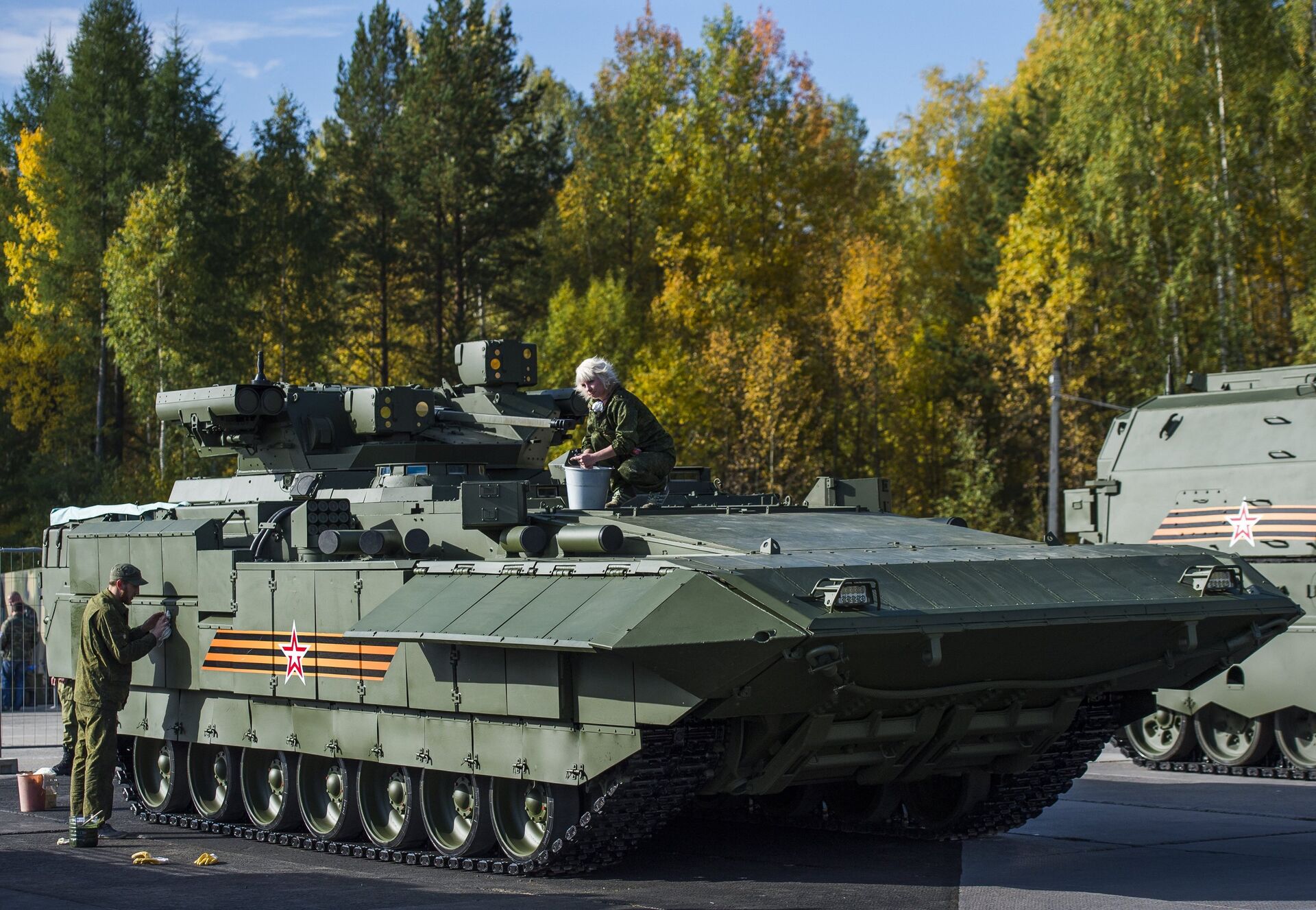https://sputnikglobe.com/20240210/big-cat-with-deadly-claws-what-we-know-about-russias-new-manul-ifv-1116712148.html
Big Cat With Deadly Claws: What We Know About Russia's New Manul IFV
Big Cat With Deadly Claws: What We Know About Russia's New Manul IFV
Sputnik International
The BMP-3 (‘Boevaya Mashina Pekhoty’, lit. ‘Infantry Combat Vehicle’) is currently the latest armored infantry carrier in the Russian Army’s arsenal. Russian defense concerns have proposed an array of upgrades, ranging from deep modernizations of the base BMP-3 model, to infantry fighting vehicle designs based on the Armata and Bumerang platforms.
2024-02-10T13:04+0000
2024-02-10T13:04+0000
2024-02-10T13:45+0000
military
ground forces
high precision systems
bmp-3
bumerang
t-15
baikal
russia
military & intelligence
https://cdn1.img.sputnikglobe.com/img/07e8/02/0a/1116711985_0:208:2901:1840_1920x0_80_0_0_b88556cbba6a185b9129c247396d1e1e.jpg
Rostec-owned defense holding company High Precision Systems and the Russian Defense Ministry are putting the finishing touches on the final design of the prospective Manul (Pallas' Cat) IFV, taking into account the experiences of the Army’s experiences in the ongoing proxy war against NATO-armed Ukrainian forces.High Precision Systems offered almost no new hints on the new IFV’s features, except to reiterate that it will include a turbocharged, 816-horsepower UTD-32T engine.What Else Do We Know About the Manul?First unveiled at a defense show in 2020, the Manul has been touted as a heavy modernization of the BMP-3, a Kurganmashzavod design that was first introduced in 1987. A unified technical base and swappability of parts with the BMP-3 means reduced development, manufacturing, and repair costs, and simplified training.Since its unveiling, the Manul has featured at least two potential weapons configurations.The prototype unveiled in 2020 was fitted with the Bumerang-BM, the same universal combat module featured on an array of other new Russian IFV designs (more below). The robotic system includes a 2A42 30 mm autocannon, four Kornet anti-tank missile launchers and a secondary PKT 7.62 mm coaxial machinegun.Variants of the system featuring a remote-operated 57 mm automatic gun, part of the AU-220M Baikal gun mount, have also since been created.The vehicle could become a modular weapons platform, with armament configuration depending on the military’s needs. In August 2023, a High Precision Systems representative confirmed to Sputnik that the Manul could serve as a base platform for a variety of purposes, from reconnaissance and command vehicles to self-propelled artillery, anti-aircraft systems, and infantry and ammunition transports.In a separate interview with Sputnik last September, Kurganmashzavod Deputy Executive Director for State Defense and Military Support Roman Khromov said Russia’s Ground Forces had expressed interest in the Manul’s front-facing engine design, and confirmed that the new IFV would borrow heavily from the base BMP-3.The IFV’s troop carrying capabilities are unknown, but the base BMP-3 has a crew of three and space for up to seven troops in its belly.What Other IFV Designs Does Russia Have in the Pipeline?The Manul is one of several prospective new IFV being put through their paces by defense manufacturers and the MoD.Others include:The Kurganets-25, another tracked Kurganmashzavod-designed infantry fighting vehicle/armored personnel carrier, first unveiled in 2015 and originally seen as a potential replacement for older, Soviet-era BMP designs. The vehicle has been undergoing extensive testing by the military, which has cited its high profile (the vehicle stands over three meters tall) as a potential risk against enemy anti-armor weapons.Formal state testing is known to have begun in 2017, and to have continued as of the fall of 2022, with upgrades to their chassis reported in late 2023. The system can be fitted with a Bumerang-BM autonomous turret. Alternatively, a AU-220M Baikal with its 57 mm autocannon and 7.62 mm 6P7K machinegun can be equipped. The Kurganets has a crew of three and room for up to eight passengers.The T-15 Armata, also unveiled in 2015, is a heavy IFV concept designed and produced by Russian tank-making giant Uralvagnozavod, another Rostec company, and is equipped with heavy armor to provide troops with maximum-possible protection in urban environments, and enough of a punch to enable it to support tank forces in encounters with enemy tanks. Based on the T-14 tank hull and featuring a front-end engine placement, the T-15 can carry seven to nine troops, and has a three-man crew situated at the center of the vehicle behind the engine compartment.The vehicle can be equipped with the Bumerang-BM or AU-220M Baikal. A variant with the DUBM-57 Kinzhal combat module has also be equipped, also featuring a 57 mm autocannon, as well as Ataka-T anti-tank guided missiles. About two dozen T-15s have been produced for evaluation purposes to date.The VPK-7829 Bumerang infantry fighting vehicle distinguishes itself from the Manul, Kurganets-25, ant T-15 with its heavy duty 4x4 wheeled configuration instead of tracks. It too is equipped with a Bumerang-BM or AU-220M Baikal remote weapons station, has a complement of three, and room for up to eight passengers. Developed by the Military Industrial Company and produced by the Arzamas Machine-Building Plant, the Bumerang was also first unveiled in 2015. State testing of the system began in April 2023, and was expected to be wrapped up by the end of the year.
baikal
russia
Sputnik International
feedback@sputniknews.com
+74956456601
MIA „Rossiya Segodnya“
2024
News
en_EN
Sputnik International
feedback@sputniknews.com
+74956456601
MIA „Rossiya Segodnya“
Sputnik International
feedback@sputniknews.com
+74956456601
MIA „Rossiya Segodnya“
what is the russian manul infantry fighting vehicle, what does bmp stand for, what is the russian bmp design, bmp, ifv, manul, armored transport
what is the russian manul infantry fighting vehicle, what does bmp stand for, what is the russian bmp design, bmp, ifv, manul, armored transport
Big Cat With Deadly Claws: What We Know About Russia's New Manul IFV
13:04 GMT 10.02.2024 (Updated: 13:45 GMT 10.02.2024) The BMP-3 (“Boevaya Mashina Pekhoty,” lit. “Infantry Combat Vehicle”) is currently the latest armored infantry carrier in the Russian Army’s arsenal. Russian defense concerns have proposed an array of upgrades, ranging from deep modernizations of the base BMP-3 model, to infantry fighting vehicle designs based on the Armata and Bumerang platforms.
Rostec-owned defense holding company High Precision Systems and the Russian Defense Ministry are putting the finishing touches on the final design of the prospective Manul (Pallas' Cat) IFV, taking into account the experiences of the Army’s experiences in the ongoing proxy war against NATO-armed Ukrainian forces.
“Currently, together with the Defense Ministry, work is underway to determine the design of the universal platform of the Manul infantry fighting vehicle. Development work has not stopped, notwithstanding the significantly increased burden of fulfilling the state defense order,” a representative from the company, which owns BMP manufacturer Kurganmashzavod, told Russian media at the World Defense Show arms expo in Riyadh earlier this week.
High Precision Systems offered almost no new hints on the new IFV’s features, except to reiterate that it will include a turbocharged, 816-horsepower UTD-32T engine.
What Else Do We Know About the Manul?
First unveiled at a defense show in 2020, the Manul has been touted as a heavy modernization of the BMP-3, a Kurganmashzavod design that was first introduced in 1987. A unified technical base and swappability of parts with the BMP-3 means reduced development, manufacturing, and repair costs, and simplified training.
Unlike the base BMP-3, which features a four-stroke, liquid-cooled diesel engine situated at the rear of the vehicle, the Manul’s engine is expected to be mounted at the front of the vehicle, returning to the concept of the original BMP-1 design.
“The Manul is a result of a deep modernization of the BMP-3,” veteran IFV designer Sergey Abdulov, the executive director and chief designer at the JSC Special Design Bureau of Mechanical Engineering, told Sputnik in an interview in 2022. “Here, at the request of the military, the engine compartment is located in front, and a spacious exit is provided at the back. But this required the installation of a remote-controlled [weapons] module on this system,” Abdulov explained.
Since its unveiling, the Manul has featured at least two potential weapons configurations.
The prototype unveiled in 2020 was fitted with the Bumerang-BM, the same universal combat module featured on an array of other new Russian IFV designs (more below). The robotic system includes a 2A42 30 mm autocannon, four Kornet anti-tank missile launchers and a secondary PKT 7.62 mm coaxial machinegun.
Variants of the system featuring a remote-operated 57 mm automatic gun, part of the AU-220M Baikal gun mount, have also since been created.
The vehicle could become a modular weapons platform, with armament configuration depending on the military’s needs. In August 2023, a High Precision Systems representative confirmed to Sputnik that the Manul could serve as a base platform for a variety of purposes, from reconnaissance and command vehicles to self-propelled artillery, anti-aircraft systems, and infantry and ammunition transports.
In a separate interview with Sputnik last September, Kurganmashzavod Deputy Executive Director for State Defense and Military Support Roman Khromov said Russia’s Ground Forces had expressed interest in the Manul’s front-facing engine design, and confirmed that the new IFV would borrow heavily from the base BMP-3.
“The chassis is the same, the transmission is the same, the electrical equipment is the same, and so on. This is an easier transition to a next-generation vehicle,” he said.
The IFV’s troop carrying capabilities are unknown, but the base BMP-3 has a crew of three and space for up to seven troops in its belly.
What Other IFV Designs Does Russia Have in the Pipeline?
The Manul is one of several prospective new IFV being put through their paces by defense manufacturers and the MoD.
The Kurganets-25, another tracked Kurganmashzavod-designed infantry fighting vehicle/armored personnel carrier, first unveiled in 2015 and originally seen as a potential replacement for older, Soviet-era BMP designs. The vehicle has been undergoing extensive testing by the military, which has cited its high profile (the vehicle stands over three meters tall) as a potential risk against enemy anti-armor weapons.
Formal state testing is known to have begun in 2017, and to have continued as of the fall of 2022, with upgrades to their chassis reported in late 2023. The system can be fitted with a Bumerang-BM autonomous turret. Alternatively, a AU-220M Baikal with its 57 mm autocannon and 7.62 mm 6P7K machinegun can be equipped. The Kurganets has a crew of three and room for up to eight passengers.
The T-15 Armata, also unveiled in 2015, is a heavy IFV concept designed and produced by Russian tank-making giant Uralvagnozavod, another Rostec company, and is equipped with heavy armor to provide troops with maximum-possible protection in urban environments, and enough of a punch to enable it to support tank forces in encounters with enemy tanks. Based on the T-14 tank hull and featuring a front-end engine placement, the T-15 can carry seven to nine troops, and has a three-man crew situated at the center of the vehicle behind the engine compartment.
The vehicle can be equipped with the Bumerang-BM or AU-220M Baikal. A variant with the DUBM-57 Kinzhal combat module has also be equipped, also featuring a 57 mm autocannon, as well as Ataka-T anti-tank guided missiles. About two dozen T-15s have been produced for evaluation purposes to date.
The VPK-7829 Bumerang infantry fighting vehicle distinguishes itself from the Manul, Kurganets-25, ant T-15 with its heavy duty 4x4 wheeled configuration instead of tracks. It too is equipped with a Bumerang-BM or AU-220M Baikal remote weapons station, has a complement of three, and room for up to eight passengers. Developed by the Military Industrial Company and produced by the Arzamas Machine-Building Plant, the Bumerang was also first unveiled in 2015. State testing of the system began in April 2023, and was expected to be wrapped up by the end of the year.
The BMP concept was pioneered by Soviet engineers in the 1960s, with the USSR, China, Czechoslovakia, and India churning out over 40,000 of the original BMP-1 over its lifespan, and up to an additional 35,000 BMP-2s produced. Large numbers of BMP-series IFVs have been spotted in the conflict in Ukraine in the ranks of both the Russian and Ukrainian armies, with Kiev’s NATO sponsors known to have padded up Ukraine's IFV inventories with dozens of older BMP-1A1s.
